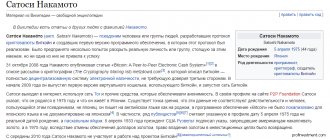Today, December 13, is exactly ten years since the anonymous creator of Bitcoin, Satoshi Nakamoto, went offline and disappeared forever.
Sponsored Sponsored
Exactly ten years ago, the man who invented Bitcoin left his last post on the forum and disappeared. No one has heard from him since then.
Satoshi Nakamoto - whoever he is hiding under this pseudonym - wrote his last post on the BitcoinTalk forum on December 12, 2010. The post would be about how to prevent denial of service (DoS) attacks on the Bitcoin network.
Sponsored
Sponsored
The next day he went offline and never came back.
Pete Rizzo, editor of the Kraken cryptocurrency exchange, tweeted: “Today is 10 years since Satoshi last wrote a post on BitcoinTalk.”
10 years ago today, Satoshi made his final post to the Bitcoin Talk forum.
The next day, he logged off, never to return.
pic.twitter.com/jnfgI1fXI6 — Pete Rizzo (@pete_rizzo_) December 12, 2020
annotation
With a peer-to-peer monetary system, it is possible to make electronic transactions between participants directly, bypassing any financial institutions. This problem is partially solved by using a digital signature, but the need for a trusted person to control double spending deprives the approach of all advantages. We offer a decentralized solution to this issue. The peer-to-peer network timestamps transactions, hashing them one after another into a chain with proof of the work done. Records generated in this way cannot be changed without re-running the entire amount of calculations. The longest version of the chain not only confirms the order of events, but also proves that the largest computing segment of the network worked on it. As long as the majority of power is held by nodes that are not united to attack the network, they will generate the longest chain, outpacing attackers. The design of the network itself is very simple: messages are sent based on the principle of “least cost”, and nodes can leave the network and reconnect at any time, accepting the longest version of the chain to reconstruct the missing transaction history.
Why does Satoshi remain anonymous?
Satoshi Nakamoto's wallets are famous and we have already written about it here before. In total, Satoshi owns 1,125,000 BTC. Add to this state all possible Bitcoin forks. It is difficult to imagine what effect even a small movement of funds in these wallets would have.
If his identity is revealed, he will become an object of persecution by journalists, intelligence services, and even ordinary bandits who will be looking for easy money. Moreover, would Bitcoin have gained such popularity without being created by an anonymous developer? This is a big question.
That is why Satoshi Nakamoto maintains his anonymity.
Introduction
Most online commerce relies on financial institutions acting as trusted intermediaries for electronic payments. This works well for most transactions, but it relies on trust, which poses certain problems. The necessary intermediation of financial institutions prevents irreversible transactions from taking place. The price of these services increases the cost of transactions and sets a minimum price, making it impossible to conduct random micropayments. In addition, the absence of irreversible transactions also increases the cost of services whose services are irreversible. Because the payment can be reversed, the seller is forced to be on guard, requiring more information from the buyer than would normally be the case. And a certain percentage of fraud is accepted as inevitable. These markups and payment uncertainties can be overcome in the case of face-to-face paper transactions, but there is no mechanism for direct electronic transactions.
What is needed is a payment system based on cryptography, rather than trust, that would allow any two participants to transfer funds directly, without the participation of an intermediary. The computational cost of canceling transactions would protect sellers from fraud, and easy-to-execute escrow schemes would protect buyers. In this paper, we propose a solution to the double-spending problem based on a distributed peer-to-peer timestamp server that verifies the chronological order of transactions with its computing power. A system is secure as long as the largest portion of its computing resources is under the collective control of honest participants.
Linguistic investigation of Peneberg
It should be noted that back in 2011, journalism professor and professional linguist Adam Penenberg from New York University conducted a linguistic analysis of Satoshi’s texts.
In his opinion, the Bitcoin developer deliberately used a British disguise to complicate the linguistic analysis of his texts, that is, he has extraordinary intelligence and knows how to cover his tracks. So the NSA could very well be in trouble. During his investigation, Adam Penenberg spent several months studying the texts of Satoshi Nakamoto and checking his specific phrases. In the end, the journalist was lucky - he discovered that a specific combination of words was found on the Internet only 26 times, mostly copies from that very document. But there is another document with the same combination of words. This is US Patent Application No. 20100042841 Updating And Distributing Encryption Keys, published in the public domain on February 18, 2010. This application describes a cryptographic system based largely on the same principles as Bitcoin technology. One fact attracted the attention of the researcher. The patent application was filed on August 15, 2008, and the bitcoin.org domain was registered on August 18, 2008 - another coincidence.
The authors of the patent application are three people: Neal King, Charles Bry and Vladimir Oksman. Further investigation made it possible to presumably determine the identities of these people. All of them are the authors of several more patents close to Bitcoin technology.
Neil King and Charles Bry are residents of Munich (Germany), and Vladimir Oksman may be Russian-born programmer Vladimir [Vova] Oksman, who lives in New Jersey and works for Samsung (Vladimir has now moved to work for Goldman Sachs , LinkedIn profile).
Two months before the launch of Bitcoin.org, the three filed another patent application, which also speaks for itself: Key Management For Communication Networks.
Neil King fits the linguistic-psychological portrait of Satoshi Nakamoto best of all, says the author of the investigation. Judging by his Facebook profile, he is a highly educated and fantastically read man, and has reviewed 46 books on Amazon, including astronomy, biology, cryptography, linguistics, literature, mathematics, philosophy and physics. Moreover, these reviews are written in an excellent literary style, very cleanly, without a single extra word or typo, just like Satoshi Nakamoto. However, like other potential co-authors, Neil King denies his involvement in Bitcoin. Six years ago, to a direct question, he gave a very lengthy answer and said that he had never heard of Bitcoin at all and had to study the Wikipedia article.
A cryptologist who has not heard of Bitcoin is about the same as a journalist who does not know about Twitter, says Adam Penenberg. He also recalled several examples of how many famous writers and inventors published their works anonymously and initially denied the fact of authorship. However, few managed to maintain anonymity forever.
Transactions
Let's define an electronic coin as a sequence of digital signatures. The next owner sends the coin to the next one, signing the hash of the previous transaction and the public key of the future owner and attaching this information to the coin. The recipient can verify each signature to confirm that the entire chain of ownership is correct.
The problem, of course, is that the recipient has no way of determining how many times the former owner spent the coin. The traditional solution is to have each transaction verified by a central trustee (the "mint" or issuer). After any payment, the coin is returned to the issuer, who issues a new version of it; and only coins directly obtained in this way can be trusted. The disadvantage of this approach is that the fate of the entire monetary system depends on the issuing company, since it, like a bank, controls every transaction passing through it.
The recipient must know that none of the previous owners signed a transaction that precedes in time the one that is in the chain of the coin sent to him. For our purposes, only the first transaction out of several is true, so we don't have to worry about late double-spending attempts. In a centralized model, the issuer knew about all transactions and decided in what order they occurred. To rid the scheme of the intermediary, participants need to openly publish transactions [1], and also be able to come to agreement on a common order of their occurrence. The recipient needs proof that for each transaction in the chain, a majority of users agree to consider it the first.
The Nobel Prize is not Satoshi's main goal
The email goes on to explain that a Nobel Prize is not among Satoshi's goals.
But why try so hard to prove this by citing your true goals? After all, you don’t need to do anything to receive the Nobel Prize. All that is required of him is to agree to the nomination to the Nobel Committee and to attend the award ceremony. Or better yet, just respond to Choudhry and let him accept the award on his behalf.
The text also contains errors that cannot be called simple typos. A native English speaker would not make such mistakes, which means the author of this letter is not one. This is where the problem arises because the text written by Satoshi Nakamoto during the development of Bitcoin was in perfect English.
Timestamp Server
Let's start describing our solution with a timestamp server. Its job is to hash the block of data to be tagged and publicly publish this hash, as in a newspaper or Usenet post [2-5]. A timestamp indicates that specific data existed at that moment and was therefore included in the block hash. Each hash includes the previous tag: this is how a chain is built, where the next link strengthens all the previous ones.
Intelligence agencies are looking for Satoshi Nakamoto
A certain Alexander Muse made a statement (of course, not supported by facts) in which he said that the National Security Agency (NSA) is actively looking for Satoshi Nakamoto. They use a technique called stylometry. Stylometry is the study and identification of a unique writing style that is unique to one person.
Using neural networks, American intelligence agencies processed a huge amount of data, trying to find people with a similar style. According to Muse, the NSA has access to all email accounts, cloud storage, documents, and so on. This amount of work was carried out in order to know for sure whether Satoshi Nakamoto is a Russian or Chinese agent.
According to the author of the report, the NSA found this person and they know who Satoshi Nakamoto is. But all information is kept in the strictest confidence.
Proof of Work
To implement a distributed peer-to-peer timestamp server, we use a “proof of work” scheme similar to Adam Beck's Hashcash system [6]. The idea is to find a value whose hash (for example, SHA-256) starts with a certain number of zero bits. The amount of work required is exponential in the number of zeros, but to verify the value found, you only need to calculate one hash.
In our timestamp server, searching for a value with the desired hash occurs by iterating over the value of the iterable Nonce field in the data block. Once a block that satisfies a condition is found, its contents cannot be changed without doing all the work again. And if it is not the last one in the chain, this work includes recalculating all the blocks following it.
Proof of work through hashing also resolves the issue of determining which version is supported by the majority. If a single IP address is considered a vote, then such a scheme can be compromised if a large range of addresses is controlled. Our scheme is based on the principle of “one processor - one vote”. The longest hash chain represents the opinion of the majority that has invested the most resources into it. If more than half of the computing power belongs to honest nodes, then the chain of honest transactions will grow faster and will outpace any competing chain. To make changes to any of the previous blocks, the attacker will have to re-work on this block and all subsequent ones, and then catch up and overtake honest participants in new blocks. Below we will show that the probability of such success for an attacker with fewer resources decreases exponentially depending on the number of blocks.
To compensate for the increasing computing power of processors and fluctuations in the number of working nodes in the network, the hashing difficulty must change to ensure a uniform block generation rate. If they appear too often, the difficulty increases, and vice versa.
Net
The system works according to the following rules:
- New transactions are broadcast to all nodes.
- Each node combines incoming transactions into a block.
- Each node tries to find a block hash that satisfies the current difficulty.
- Once such a hash is found, this block is sent to the network.
- Nodes accept this block only if all transactions in it are correct and do not use funds already spent.
- Nodes express their agreement with the new data by starting work on the next block and using the hash of the previous one as the new initial data.
Participants always consider the longest version of the chain to be true and work to lengthen it. If two nodes simultaneously publish different versions of the next block, then some of the other peers will receive one version earlier, and some will receive the other. In this case, everyone will start working on their own version of the chain, saving the other one in case it ends up being continued earlier. The duality will disappear as soon as a new block is received that continues either branch, and those nodes that were working on the competing version switch to it.
New transactions do not need to reach all nodes. If enough nodes know about them, they will soon end up in one of the blocks. Block distribution rules are also not strict regarding lost messages. As soon as the node that missed one of the blocks receives the next one, it will ask for the missing information to fill in the obvious gap.
Goals and aspirations
It is known that the creator of Bitcoin adheres to libertarian views. It's not that he had strong anti-government sentiments, but he was trying to give control of personal finances to people outside the global banking system, as well as free people from mandatory taxation. In the Bitcoin Genesis block, often referred to as block 0 or block 1, Satoshi embedded a message in the coinbase parameter:
"The Times 03/Jan/2009 Chancellor on brink of second stage bail-out of banks."
The term “bail-out” means saving banks at the expense of the state.
Of course, this is not necessarily a political statement and could simply serve as a timestamp to prove that the Genesis block was created on or after January 3, 2009. However, this message is widely seen as an admission of the ability of central banks to print endless amounts of currency at will, slowly destabilizing it and reducing its value, without providing any public accountability for their actions. By creating a digital currency, the maximum amount of which is determined at the level of mathematical calculations, the chances of Bitcoin inflation are reduced to zero.
Despite mining about 980,000 BTC, Satoshi Nakamoto's wallet address was used for only one transaction, which was supposed to clearly demonstrate the functionality of the cryptocurrency. Why has he never touched his capital since then? Below are the supposed reasons why the creator of Bitcoin never moved his coins:
- As the creator of Bitcoin, he knew that the digital currency was not actually completely anonymous, so by moving coins around, he might accidentally reveal more information about his identity than he intended;
- he mined coins using addresses not associated with his main wallet, which allowed him to accumulate such a significant fortune without moving the mined coins;
- he believes that moving such a huge amount of BTC (approximately 1/17 of the total number of Bitcoins created) could have a negative psychological impact on the price and stability of the cryptocurrency;
- he is no longer among the living;
- he is bound by some contract, oath, or agreement that he will never touch his coins;
- he lost access to private keys.
Stimulation
By default, the first transaction in a block is a special one that creates a new coin that belongs to the creator of the block. This scheme is an incentive for participants, encouraging them to maintain the operation of the network, and also resolves the issue of the initial distribution of the money supply in the absence of a central issuer. The uniform increase in the number of coins in circulation can be compared to gold mining, in which gold miners also invest their resources. The latter in our case are processor time and electricity.
Another way to incentivize could be through transaction fees. If the input payment amount is greater than the output payment amount, then the difference is a transfer fee and is added to the base value of the reward for the block found in the first transaction. Once the total volume of money supply reaches a predetermined maximum, the only source of incentive for work on blocks will be commissions, free from inflation.
This form of incentive may also help reduce fraud. If a greedy attacker is able to allocate more computing power than all honest participants, he can deceive merchants by voiding his transactions and returning funds, or use his resources to generate new blocks and coins. More profitable for him is the option of “playing by the rules,” which ensures that he receives more than half of all new money, than the option of “sabotaging the system” and maintaining his capital at a constant level.
What does the name Satoshi Nakamoto mean?
Today, most experts are of the opinion that this name is fictitious, so it is worth studying the question of what it means.
Literally translated from Japanese, “satoshi” means “wise.” This is a rather unusual masculine name in the Land of the Rising Sun, which has many definitions hinting at change: “rising from the ashes like a phoenix”, “clear thought” or “witty”. All this is quite closely related to Bitcoin and its original structure, which has a high degree of security.
The word "nakamoto" translates as "one who lives in the middle." The name is most common in the Ryukyu Islands, an island chain southwest of Japan that includes the islands of Anami, Okinawa and Sakishima. This region, formerly known as the Ryukyu Kingdom, was independent from Japan between the 15th and 19th centuries and played an important role in the development of the region's maritime trade routes.
For hundreds of years, the Ryukyu Kingdom paid tribute to China, enjoying certain trade rights and receiving diplomatic and technical support in exchange. In some ways, this is reminiscent of the current cryptocurrency ecosystem.
In general, the name Satoshi Nakamoto can be translated as “the wise one who lives in the middle.”
Saving disk space
Once the last transaction on a chained coin is inside a sufficiently old block, all previous transactions on the chain can be deleted to clear disk space. To ensure that the block hash remains unchanged, all transactions in the block are stored in the form of a Merkle hash tree [7][2][5] and only its root is included in the block hash. The size of old blocks can be reduced by removing unnecessary branches of this tree; storing intermediate hashes is not necessary.
The empty block header will be about 80 bytes. Based on the rate of block generation every ten minutes, we get 80*6*24*365=4.2 MB per year. For the average (as of 2008) computer with 2 GB of RAM, taking into account Moore's law, which predicts growth of 1.2 GB per year, data storage will not be a problem, even if all block headers are in memory.
Artifice
What follows looks like the invention of a person exhausted by the current situation. Or the forger simply lacked inspiration.
The government and secret agents harass Satoshi. If they don't leave him alone, he'll abandon the project, "and they'll all end up destroying themselves." Satoshi wanted to help the poor, but he is annoyed by the selfish representatives of humanity. He regrets the invention of blockchain because it ruined his life.
"I'm over it"!
Perhaps this sounds like a threat. What could he do to us? Shut down all nodes on the Bitcoin network?
Even if you don't take into account the grammatical errors that permeate the entire letter, the last third of the letter really looks like a cheat and sounds like nonsense. A genius wouldn't write something like that. But let the readers decide for themselves whether to believe this letter or not.
However, keep in mind that geniuses are generally strange people, and in some cases even very strange. Therefore, it is too early to draw final conclusions about this letter.
Simplified payment verification
Verification of transactions is possible without launching a fully functional node. The user only needs to store the block headers of the longest chain he has received from other nodes and query the hash subtree for the required transaction. He cannot verify the correctness of the transaction on his own, but by receiving a link to the block in which it is located, he can make sure that this block and all subsequent ones are accepted and confirmed by the network.
This verification method can be relied upon as long as the network is under the control of honest participants, that is, until the attacker takes over large resources. Regular nodes can verify transactions on their own, but if an attacker generates the longest chain of blocks, then he can compromise the simplified scheme with his forged transactions. One strategy to counter this would be to send out alarms from regular peers that receive a “false” block. Such a signal will force the client program to load the entire block in order to independently confirm the incorrectness of the data. Companies that frequently accept payments will probably connect to the network as usual for greater independence, security and faster verification.
Thorough examination of the email
The first thing that made me wonder is the fact that this is not the first letter claiming that Satoshi is now associated with Ethereum. This is the second time this kind of statement has come across my eyes. I already read about this in an email from supposedly Satoshi, published in another publication.
So let's get started. The very first line raises suspicions.
If the development of Bitcoin, most of its concepts, and the implementation of the technology itself is the achievement of one person, that person is truly a genius. But the author of the letter states in the very first line that he is not hiding. But in reality he is hiding, beyond any doubt. A reckless mistake for a genius.
Or maybe he is hiding, being under close attention? After all, he is a cryptographer. Smart.
Combining and splitting amounts
Although it is possible to operate on individual coins, creating a special transaction for each cent would be too inconvenient. To support dividing and combining amounts, transactions contain multiple inputs and outputs. A typical transaction would look like this: either one input from a previous large payment, or several inputs accumulating small amounts, and no more than two outputs: one is the actual payment, and the other, if necessary, returns “change” back to the sender.
It should be noted that the increase in connections, when a transaction depends on several, which in turn depend on even more, is not a problem, since there is no need to obtain a complete and independent copy of the transaction history.
Bitcoin's Goals Misrepresented
The letter goes on to talk about another goal - “to free Bitcoin from the greedy representatives of the so-called elite to enable ordinary miners to mine Bitcoins.”
This got me thinking. If the letter is a scam, it should be noted that the scammer is quite smart: not many would have thought that bitcoins are not mined by ordinary people, as was originally intended. On the other hand, it cannot be said that Bitcoin mining is in the hands of the elite. Of course, mining makes a lot of money for large institutions, but these institutions are the ones who pinned their hopes on Bitcoin many years ago, ordinary people who believed in it and were able to raise the necessary funds to create mining sites or pool platforms for small miners. Satoshi should have foreseen a large investment, because this is inevitable when you are dealing with technology that brings in a lot of money. Large investors always appear sooner or later.
Privacy
The traditional banking model maintains the required level of privacy by providing access to information only to the participating parties and a trusted third party. The need to publicly publish transactions precludes this approach, but privacy can still be maintained if public keys are anonymous. Information will be open that someone sent someone a certain amount, but without reference to specific individuals. The same amount of data is disclosed on stock exchanges, which publish the time and volume of private transactions without indicating between whom they were made.
Additional protection will be the generation of a new public/private key pair for each transaction: this will prevent different payments from being associated with their common sender or recipient. Some public linking is still inevitable: transactions with multiple inputs prove that these amounts belong to one person. The risk is that revealing the identity of the key owner could lead to the disclosure of all transactions belonging to him.
Despite the denials, still a candidate
Vitalik, an “art creator” and the son of programmer Dmitry Buterin, began his programming career quite early by writing code for small games.
“When I was 10, I started writing games in C++ using Allegro. At first it was games like Bounce Ball, but gradually I moved on to more complex games like Tower Defense and Space Invaders. Essentially, I created games that I then played myself in an attempt to beat myself. As soon as I won one game, I moved on to create another."
Vitalik entered the Bitcoin world seven years later:
“I first heard about it over dinner from my dad when I was 17. I didn't take the technology seriously at first because it didn't seem to have any actual value and no one would accept it. However, a few weeks later I came across a discussion about Bitcoin on the Internet and came to the conclusion that there might actually be something to this technology.”
Calculations
Consider a scenario in which an attacker tries to generate a longer chain of blocks than honest participants. Even if he succeeds, this will not lead to the possibility of creating money out of thin air, appropriating other people's coins, or making other arbitrary changes. Nodes will never accept an incorrect transaction or the block containing it. The attacker can only try to change one of his transactions to get his money back.
The race between honest participants and the attacker can be represented as a binomial random walk. A successful event, when a “good” chain is extended by one block, leads to an increase in the lead by one, and an unsuccessful event, when the next block is created by an attacker, leads to its reduction.
The attacker's probability of making up a difference of several blocks is the same as in the "player ruin" problem. Let's imagine that a player has unlimited credit, starts with some deficit, and has an infinite number of attempts to win back. The probability that he will succeed, as well as the probability of the attacker catching up with honest participants, is calculated as follows [8]:
In the case p > q, the probability decreases exponentially with the number of blocks by which the attacker is behind. Since all bets are against him, without a successful push at the beginning, his chances of success become negligible.
Let's now consider how long the payee should wait before being completely confident that the former owner will not be able to reverse the transaction. We assume that the malicious sender allows the recipient to believe for some time that the payment has been made, after which he returns the money to himself. The recipient finds out about this, but the scammer hopes it will be too late.
The recipient creates a new key pair and shares their public key with the sender right before signing the transaction. This will prevent the sender from working on the chain early and making a transaction at the moment when he is lucky enough to make a leap forward. After sending the payment, the fraudster begins to secretly work on a parallel version of the chain containing an alternative transaction.
The recipient waits until the transaction is added to the block and until it continues with z more blocks. He does not know the progress of the attacker, but if the average rate of generation of honest blocks is a known value, then the number of blocks of the attacker obeys the Poisson distribution with the mathematical expectation
To get the probability that the attacker will overtake honest participants, we multiply the value of the random variable (the number of blocks he created) by the probability that he will be able to make up the remaining difference:
Regrouping the terms and getting rid of the infinite series, we get:
The program code in C language looks like this:
#include double AttackerSuccessProbability(double q, int z) { double p = 1.0 - q; double lambda = z * (q / p); double sum = 1.0; int i, k; for (k = 0; k <= z; k++) { double poisson = exp(-lambda); for (i = 1; i <= k; i++) poisson *= lambda / i; sum -= poisson * (1 - pow(q / p, z - k)); } return sum; }
Running the program, we see that the probability decreases exponentially as z increases:
q=0.1 z=0 P=1.0000000 z=1 P=0.2045873 z=2 P=0.0509779 z=3 P=0.0131722 z=4 P=0.0034552 z=5 P=0.0009137 z=6 P=0.0002428 z=7 P= 0.0000647 z=8 P=0.0000173 z=9 P=0.0000046 z=10 P=0.0000012 q=0.3 z=0 P=1.0000000 z=5 P=0.1773523 z=10 P=0.0416605 z=15 P=0.0101008 z=20 P =0.0024804 z=25 P=0.0006132 z=30 P=0.0001522 z=35 P=0.0000379 z=40 P=0.0000095 z=45 P=0.0000024 z=50 P=0.0000006
Solving the equation for P < 0.1%, we obtain:
P < 0.001 q=0.10 z=5 q=0.15 z=8 q=0.20 z=11 q=0.25 z=15 q=0.30 z=24 q=0.35 z=41 q=0.40 z=89 q=0.45 z= 340
One interesting option
As mentioned at the beginning of the article, whether true or false, the letter got us thinking. The first thing that came to mind was that the person who created Bitcoin (if the project can be attributed to one person) could not stop developing innovative software and systems. He would still be active and very likely most active in the Bitcoin, i.e. cryptocurrency space. Such brilliant minds cannot be stopped. They find pleasure in creating and thinking. The creator of Bitcoin is just such a person.
This consideration brings us back to Vitalik Buterin, who is the founder of the Ethereum project, which means he is a good contender for the true identity of Satoshi Nakamoto, if this letter is to be believed.
Vitalik has Russian roots. He was born in Russia in 1994 and moved to Canada in 2008.
When he moved to an English-speaking country, he was 6 years old. Now he is 21 years old. However, Vitalik is fluent in English, as can be seen from his recent interview. But there's one more catch: if Vitalik is Satoshi, he must have been about 15 years old when Bitcoin software was completed. It's not that far-fetched. Some children are so smart that it takes the breath away of adults when they realize that they themselves could never have thought of such a thing.
In the email, Satoshi also mentions a charitable foundation. Could a 15-year-old be so sympathetic to orphans that he would devote so much time to developing technology to help such an organization? It's possible, but unlikely. I don't remember what exactly I cared about at that age, but for the most part it was girls and video games.
Another interesting fact can be found on Vitalik’s About.me page: he claims that he entered university in 2012, “but soon dropped out to take a six-month trip around the world, while constantly participating in projects related to cryptocurrency. The result of the journey was the idea of creating Ethereum.” Bitcoin was also launched in 2012. It was on everyone's lips, so he, as the creator, did not need even more attention.
In 2013, he made one remarkable statement: “Bitcoin is a bridge technology.”
Net
The system works according to the following rules:
- New transactions are broadcast to all nodes.
- Each node combines incoming transactions into a block.
- Each node tries to find a block hash that satisfies the current difficulty.
- Once such a hash is found, this block is sent to the network.
- Nodes accept a block only if all transactions in it are correct and do not use funds already spent.
- Nodes express their agreement with the new data by starting work on the next block and using the hash of the previous one as the new initial data.
Participants always consider the longest version of the chain to be true and work towards
its lengthening. If two nodes simultaneously publish different versions of the next block, then some of the other peers will receive one version earlier, and some will receive the other. In this case, everyone will start working on their own version of the chain, saving the other one in case it ends up being continued earlier. The duality will disappear as soon as a new block is received that continues either branch, and those nodes that were working on the competing version switch to it. New transactions do not need to reach all nodes. If enough nodes know about them, they will soon end up in one of the blocks. Block distribution rules are also not strict regarding lost messages. As soon as the node that missed one of the blocks receives the next one, it will ask for the missing information to fill in the obvious gap.











